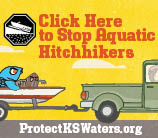Frequently Asked Questions about Using Bait Fish
Frequently Asked Questions about Using Bait Fish
The following questions and answers can help you determine the legality of different scenarios when using live bait.
Can I collect bait at a lake and then use it below the dam in the stream or spillway?
Can I collect bait at a reservoir/lake and then transport in a car to the other side of the lake to use?
Can I collect bait in the stream/river and use as live bait in the downstream impoundment?
Where can I use live stream/river caught bait?
Can I collect bait from a pond and take it to the lake or stream?
The answer to these questions depends on waterbody classification (designated aquatic nuisance water or non-designated aquatic nuisance water) and species (a special exception applies to bluegill and green sunfish):
---------------------------------------------------------------------------------------------------------------------------------------------
* Non-designated aquatic nuisance water:
Live baitfish, crayfish, leeches, amphibians, and mussels may be caught and used as live bait only within the common drainage where caught and shall not be transported and used above any upstream dam or barrier that prohibits the normal passage of fish.
* Designated aquatic nuisance water:
Live baitfish, crayfish, leeches, amphibians, and mussels may be caught and used as live bait only within the common drainage where caught and shall not be transported and used above any upstream dam or barrier that prohibits the normal passage of fish. If collected from a designated aquatic nuisance water, live baitfish, crayfish, leeches, amphibians, and mussels shall be possessed or used as live bait only while on that water and shall not be transported from the water alive. That means you can use live bait caught at that water, but if you leave the property of the entity owning land surrounding that water, the bait must be dead first. This allows you to drive from the boat ramp to the fish cleaning station or campsite only to return directly to the lake at a later time, provided you do not leave the property. If you can get from one side of the lake to the other without leaving the property, the transport is legal.
* Bluegill and green sunfish exception:
Bluegill and green sunfish collected from non-designated aquatic nuisance waters may be possessed or used as live bait anywhere in the state.
---------------------------------------------------------------------------------------------------------------------------------------------
Can I collect bait from a private water fishing impoundment?
Yes. To determine the legality of this movement, consider the impoundment you are using as your bait source and compare to the definition in K.S.A 32-701(o): "Private water fishing impoundment" means one or more water impoundments:
- Constructed by man rather than natural, located wholly within the boundary of the lands owned or leased by the person operating the private water impoundments; and
- entirely isolated from other surface water so that the impoundment does not have any connection either continuously or at intervals, except during periods of floods, with streams or other bodies of water so as to permit the fish to move between streams or other bodies of water and the private water impoundments, except that the private water impoundments may be connected with a stream or other body of water by a pipe or conduit if fish will be prevented at all times from moving between streams or other bodies of water and the private water impoundment by screening the flow or by other means.
Can I purchase bait and then transport it to wherever I want?
Yes. Rules are in place to ensure that bait sold from Kansas commercial bait dealers has been inspected for disease and ANS. If you fish at an ANS designated water, all fish must be dead before you leave the property, even your bait fish.
Do I have to drain all water when leaving an area?
Yes. Water must be drained and the drain plug removed from all boat bilges and livewells prior to transport on a public road. You can take water away in a bucket, but it must not contain any illegal wildlife such as zebra mussel larvae (veligers). It is against state and federal law to possess, import, and transport live invasive species (K.A.R. 115-18-10). As zebra mussel veligers are microscopic, the best practice would be to not take water away with you. In 2006 biologists looked at the number of zebra mussel veligers in a typical livewell/bilge system. It was discovered that boats leaving a reservoir that contained zebra mussels could have spread 468-975 veligers per boat by not draining.
The rule says I cannot possess live fish upon departure from any designated aquatic nuisance water. What is considered dead?
Fish cannot be alive. That means the fish must look and act dead. We recommend that you cut the fish, pack the fish on ice, or haul away in a dry container. A good technique is to freeze water in milk jugs and use them to keep your harvested fish fresh when hauling them home.
What do I do with my unused bait?
Do not release the bait into the water. Dispose of the bait on dry ground or in an approved bait receptacle.










